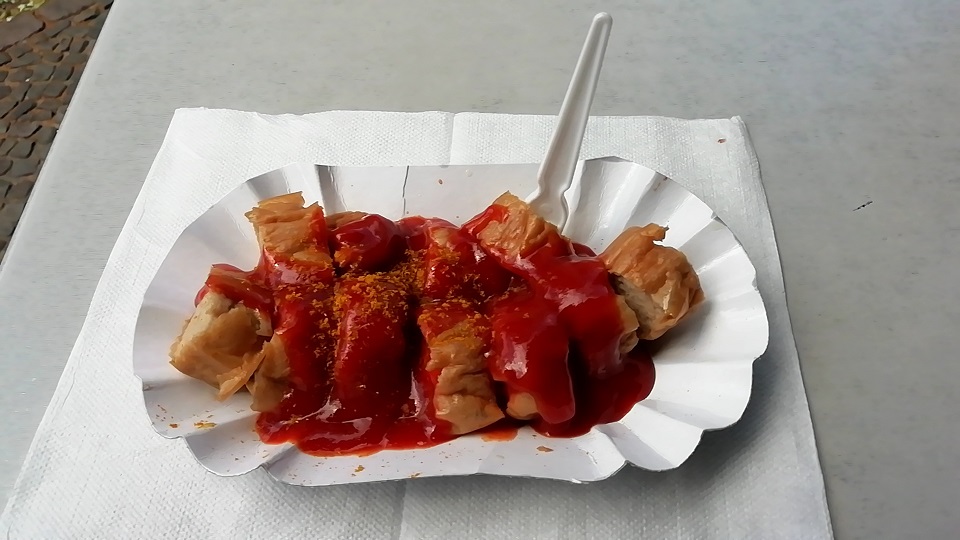
table of contents
Environmental pollutant inspection
Environmental pollutant inspection results of October 2015
Excerpt from record 2
the first page
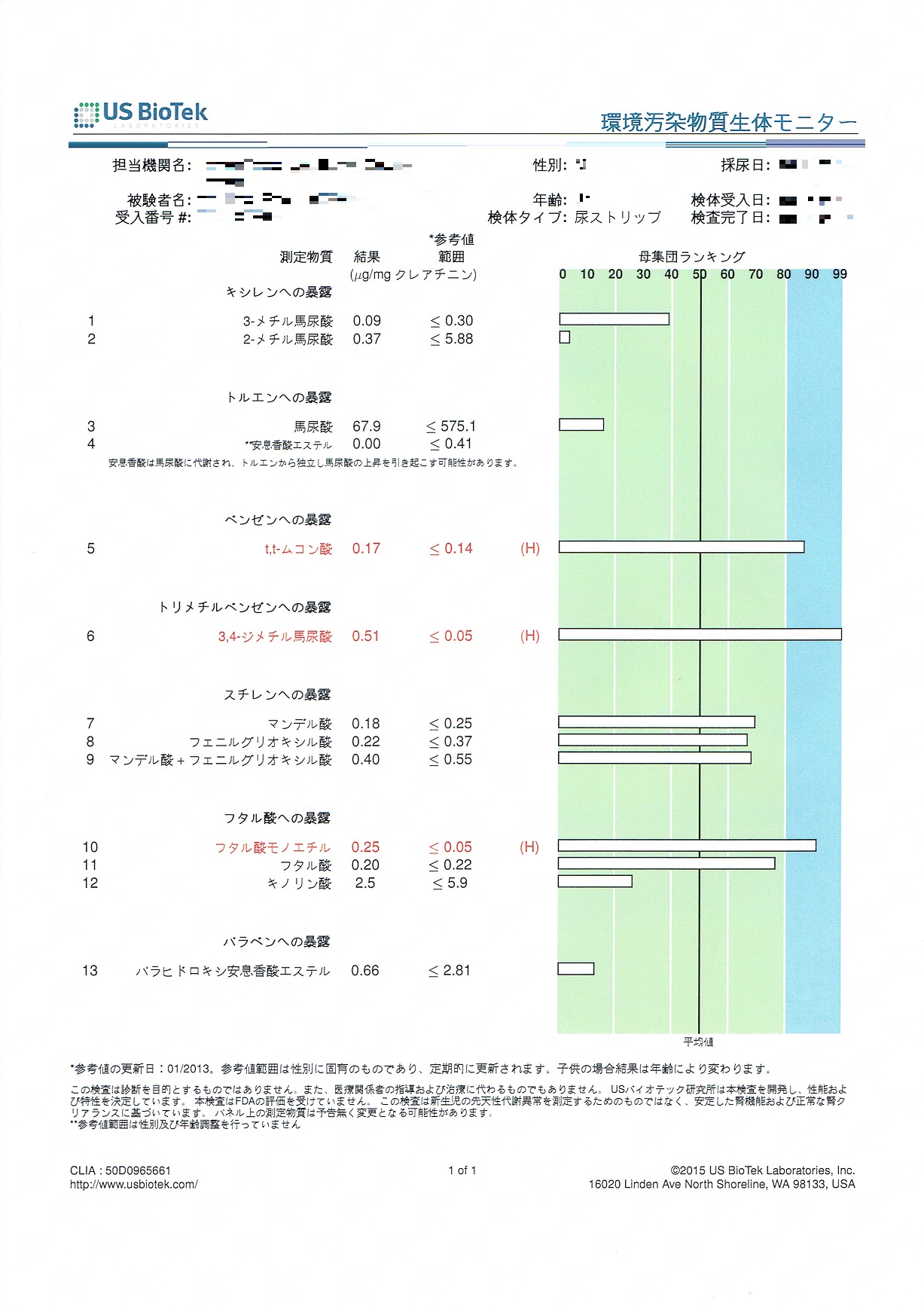
Measuring substance result range Population ranking
Exposure to xylene
1 3-methyl hippuric acid
2 2-methyl hippuric acid
Exposure to toluene
3 Hippuric acid
4 *Benzoic acid ester
Benzoic acid is metabolized to hippuric acid, which can cause an increase in hippuric acid that is independent of toluene.
Exposure to benzene
5 t, t-muconic acid
Exposure to trimethylbenzene
6 3,4-dimethyl hippuric acid
Exposure to styrene
7 Mandelic acid
8 Phenylglyoxylic acid
9 Mandelic acid + phenylglyoxylic acid
Exposure to phthalic acid
10 Monoethyl phthalate
11 Phthalic acid
12 Quinolinic acid
Exposure to parapen
13 Para-hydroxybenzoic acid ester
* Reference date updated: January 2013.Reference range is gender specific and will be updated regularly.For children, the results will vary depending on age.
This test is not for diagnostic purposes.
It also does not replace the guidance and treatment of medical personnel.
The US Biotech Institute has developed this test to determine its performance and characteristics.
This test has not been evaluated by the FDA.
This test is not for measuring inborn errors of metabolism in the newborn and is based on stable renal function and normal renal clearance.
The substances to be measured on the panel are subject to change without notice.
** Reference value range is not adjusted by gender or age
2nd page
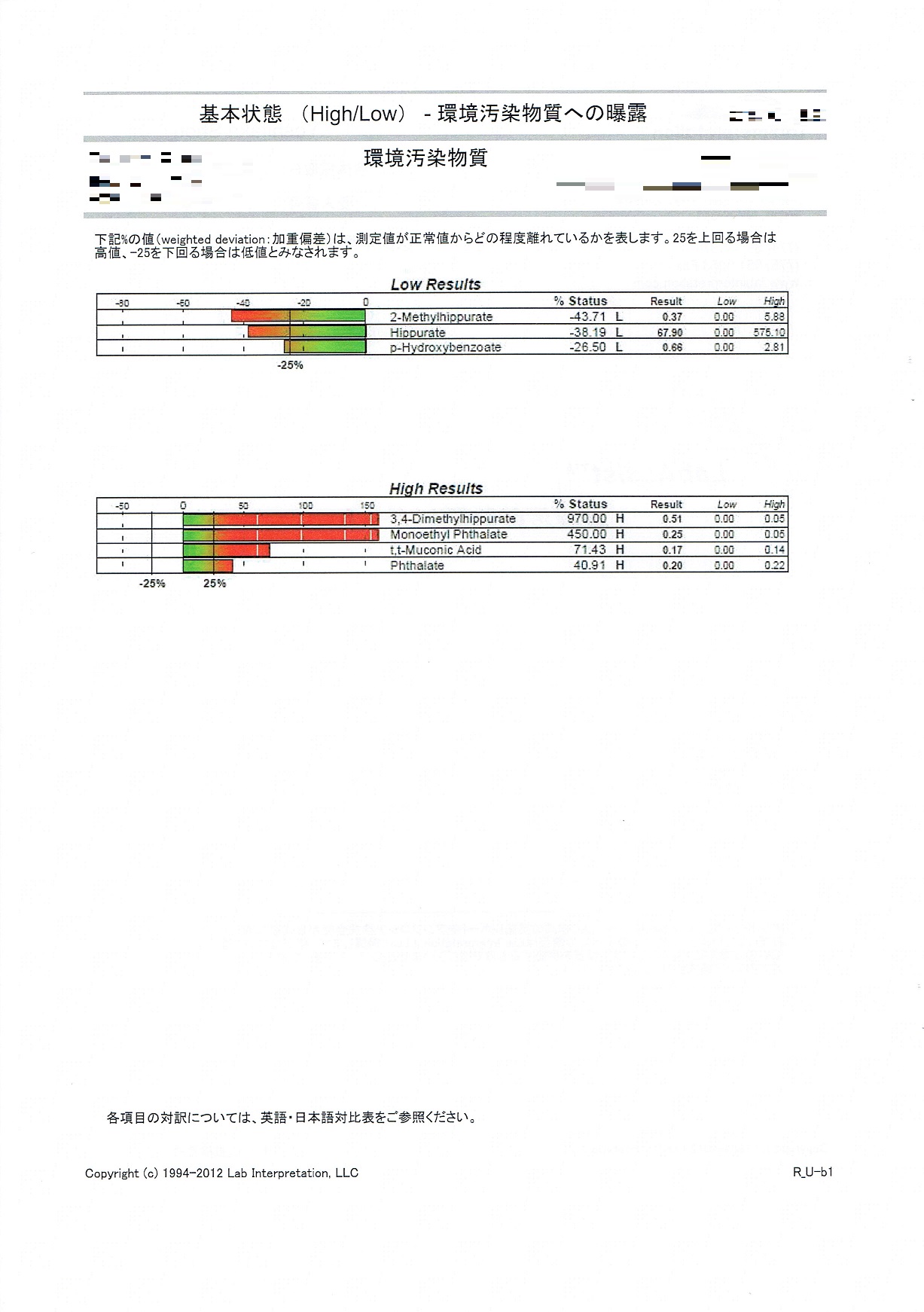
Basic condition (High / Low) -exposure to environmental pollutants
Environmental pollutants
The% value (weighted deviation) below indicates how far the measured value is from the normal value.
A value above 25 is considered high and below -25 is considered low.
3nd page
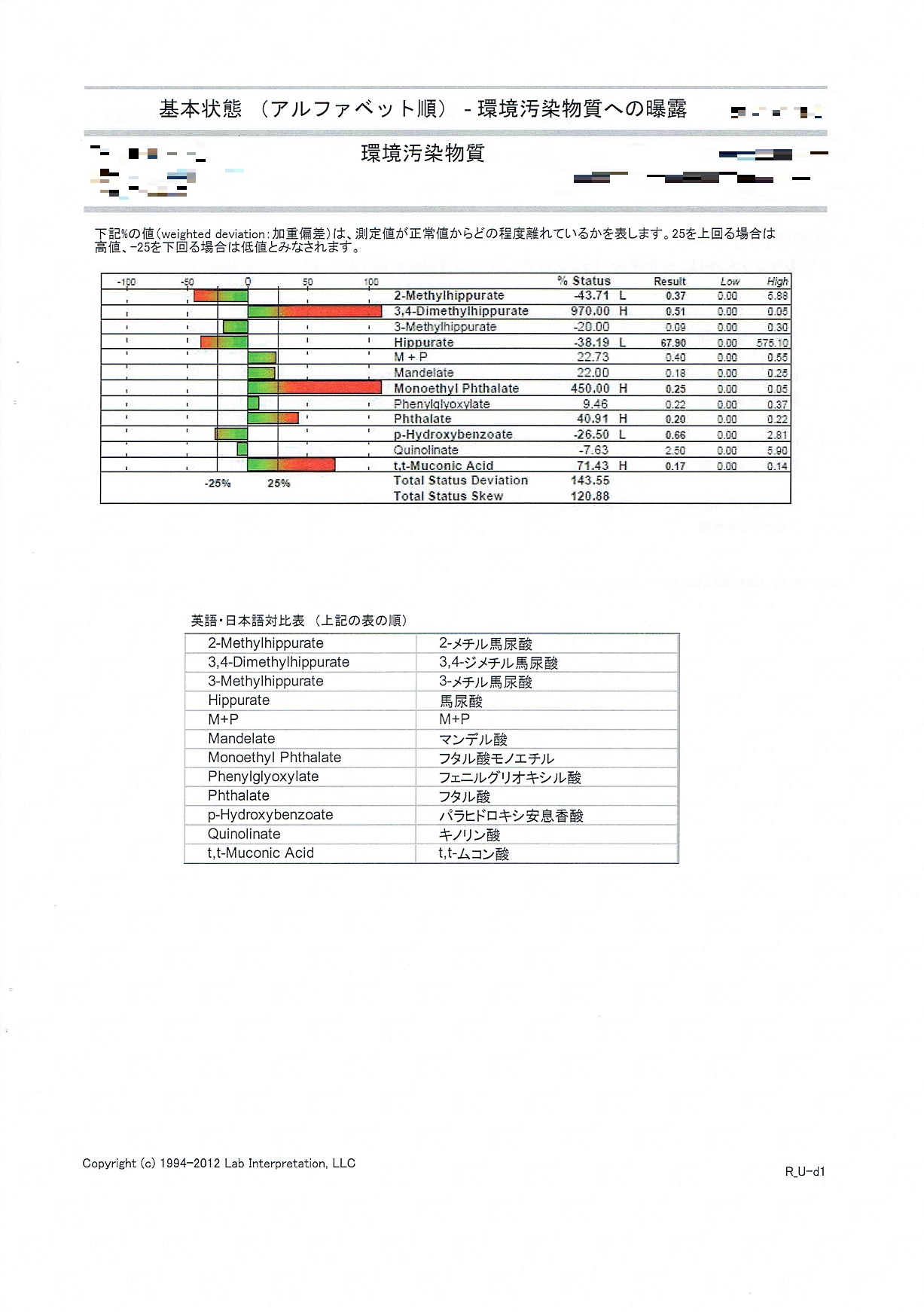
Basic condition (alphabetical order) -exposure to environmental pollutants
Environmental pollutants
The% value (weighted deviation) below indicates how far the measured value is from the normal value.
A value above 25 is considered high and below -25 is considered low.
4nd page
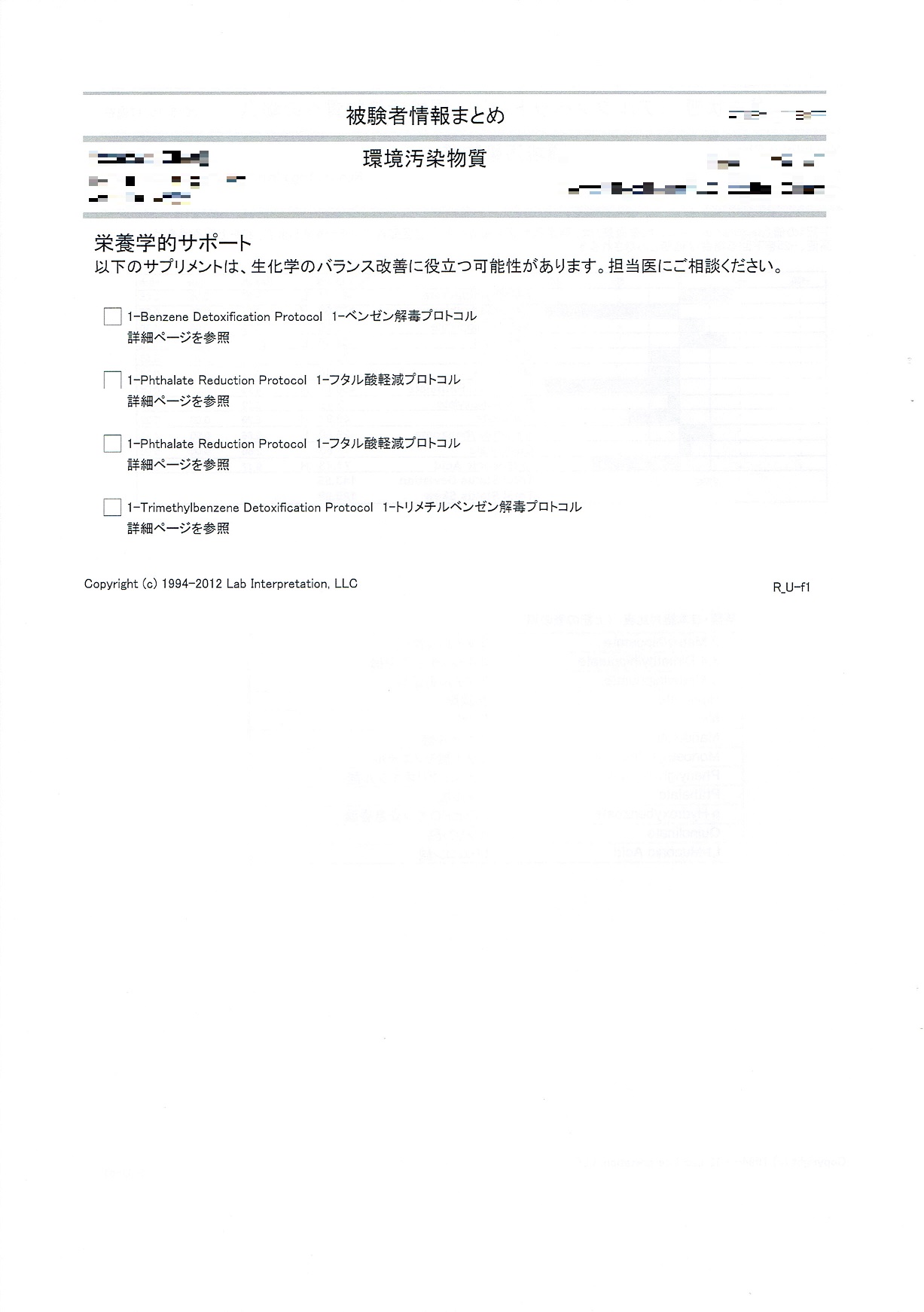
Subject information summary
Environmental pollutants
Nutritional support
The following supplements may help improve your biochemistry balance. Please consult your doctor.
5nd page
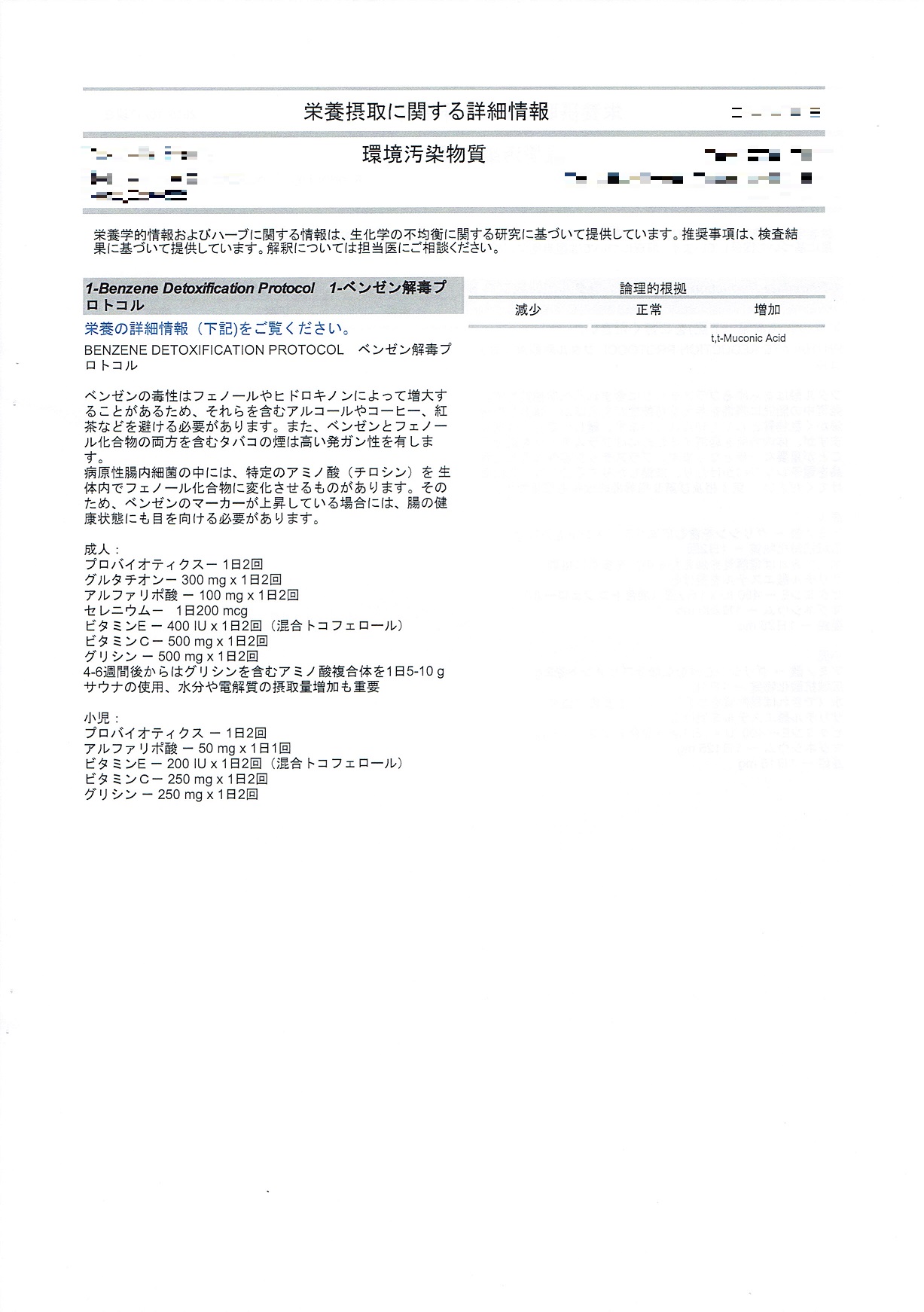
More information on nutrition
Environmental pollutants
Nutritional and herbal information is provided based on studies of biochemical imbalances.
Recommendations are provided based on test results.
Please consult your doctor for interpretation.
See detailed information on nutrients below.
Benzene’s toxicity can be exacerbated by phenol and hydroquinone, so alcohol, coffee, and tea containing them should be avoided.
Also, cigarette smoke, which contains both benzene and phenolic compounds, is highly carcinogenic.
Some pathogenic enterobacteria cause the body to convert certain amino acids (tyrosines) into phenolic compounds.
So if your benzene marker is elevated, you should also look at your gut health.
Adult:
Probiotics-twice a day
Glutathione-300 mg x 2 times a day
Alpha lipoic acid-100 mg x twice a day
Selenium-200 mg daily
Vitamin E-400 IU x twice a day (mixed tocopherol) *IU (International Unit)
Vitamin C-500 mg x twice a day
Glycine-500 mg x twice a day
After 4-6 weeks, amino acid complex containing glycine 5-10 g / day
Using a sauna and increasing your intake of electrolyzed water are also important
Child:
Probiotics-twice a day
Alpha lipoic acid-50 mg x twice a day
Vitamin E-200 IU x twice a day (mixed tocopherols)
Vitamin C-250 mg x twice a day
Glycine-250 mg x twice a day
6nd page
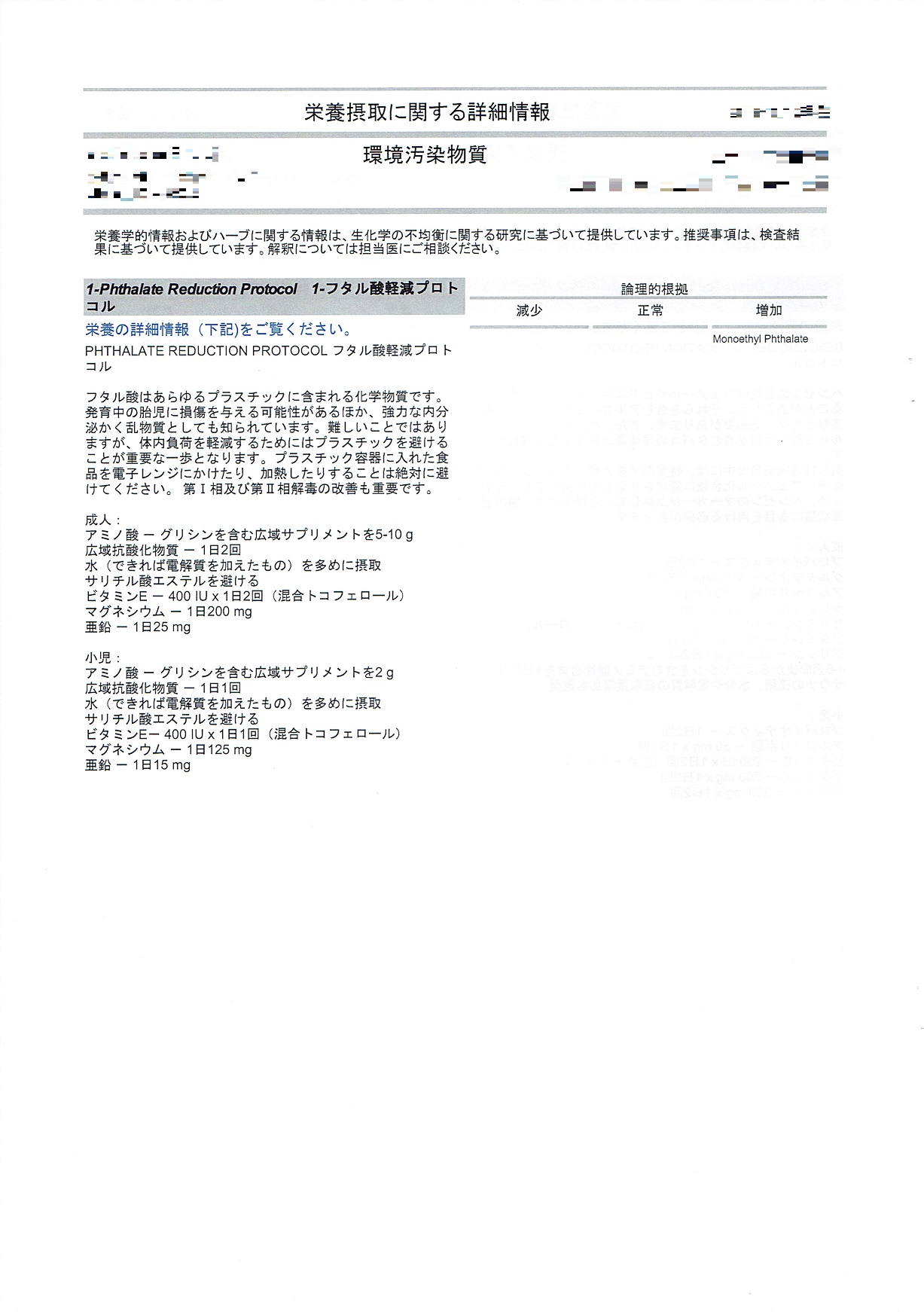
More information on nutrition
Environmental pollutants
Nutritional and herbal information is provided based on studies of biochemical imbalances.
Recommendations are provided based on test results.
Please consult your doctor for interpretation.
See detailed information on nutrients below.
Phthalic acid is a chemical contained in all plastics.
It can cause damage to the developing fetus and is also known as a potent endocrine disruptor.
Although difficult, in order to reduce the burden on the body, never microwave food or heat food in plastic containers.
Improving Phase I and Phase II detoxification is also important.
Adult:
5-10g wide range supplement containing amino acids-glycine
Broad spectrum antioxidants-2 times a day
Ingest a large amount of water (preferably electrolyte added)
Avoid salicylate
Vitamin E-400 IU x 2 times a day (mixed tocopherols)
Magnesium 200 mg daily
Zinc-25 mg / day
Child:
2g wide range supplement containing amino acids-glycine
Broad spectrum antioxidants-once a day
Ingest a large amount of water (preferably electrolyte added)
Avoid salicylates
Vitamin E-400 IU x once a day (mixed tocopherol)
Magnesium-125 mg daily
Zinc-15 mg daily
7nd page
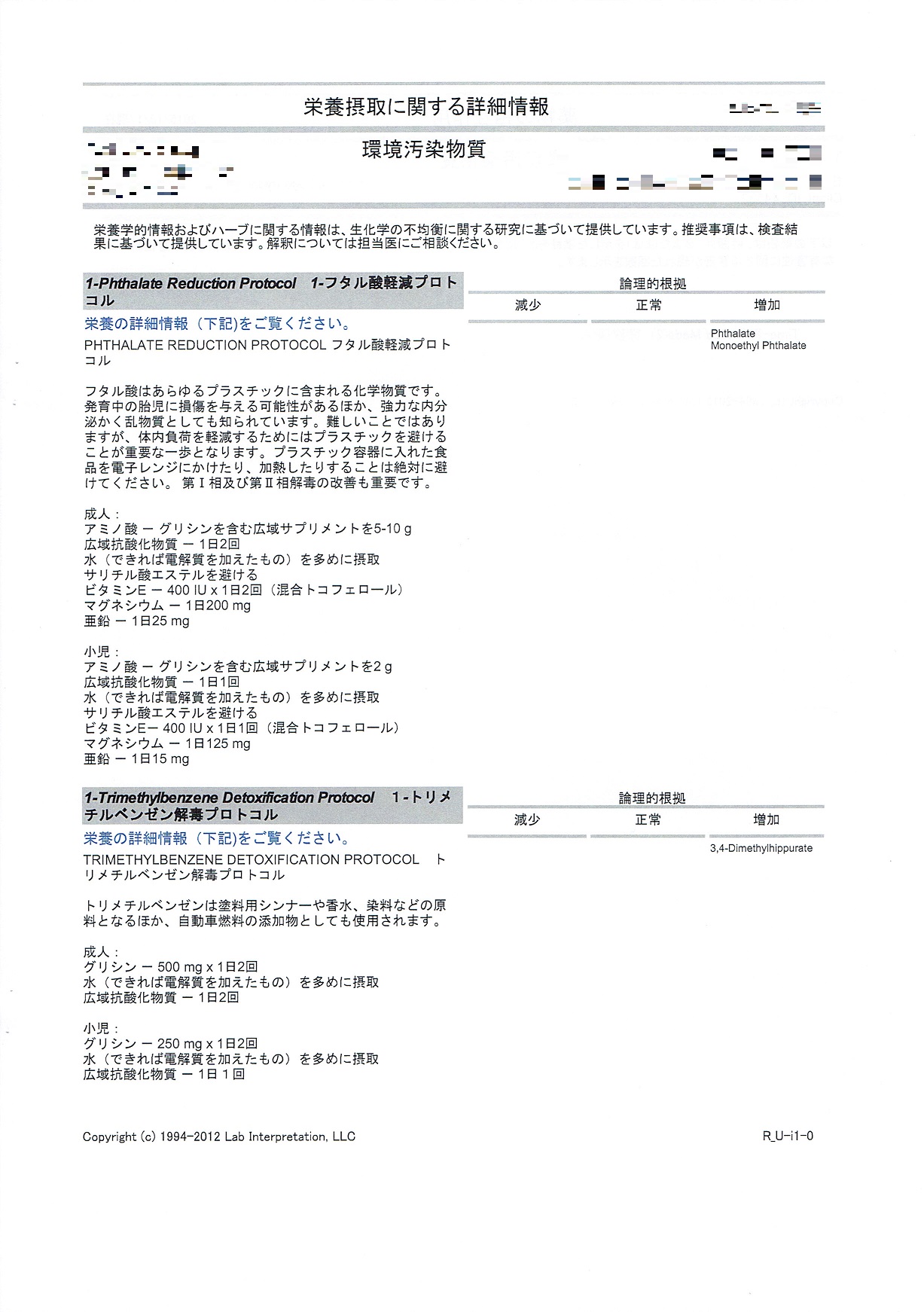
More information on nutrition
Environmental pollutants
Nutritional and herbal information is provided based on studies of biochemical imbalances.
Recommendations are provided based on test results.
Please consult your doctor for interpretation.
See detailed information on nutrients below.
Phthalic acid is a chemical contained in all plastics.
It can cause damage to the developing fetus and is also known as a potent endocrine disruptor.
Although difficult, in order to reduce the burden on the body, never microwave food or heat food in plastic containers.
Improving Phase I and Phase II detoxification is also important.
Adult:
5-10g wide range supplement containing amino acids-glycine
Broad spectrum antioxidants-2 times a day
Ingest a large amount of water (preferably electrolyte added)
Avoid salicylate
Vitamin E-400 IU x 2 times a day (mixed tocopherols)
Magnesium 200 mg daily
Zinc-25 mg / day
Child:
2g wide range supplement containing amino acids-glycine
Broad spectrum antioxidants-once a day
Ingest a large amount of water (preferably electrolyte added)
Avoid salicylates
Vitamin E-400 IU x once a day (mixed tocopherol)
Magnesium-125 mg daily
Zinc-15 mg daily
See detailed information on nutrients below.
Trimethylbenzene is used as a raw material for paint thinners, perfumes and dyes, and is also used as an additive for automobile fuels.
Adult:
Glycine-500 mg x twice a day
Ingest a large amount of water (preferably electrolyte added)
Broad spectrum antioxidants-2 times a day
Child:
Glycine-250 mg x twice a day
Ingest a large amount of water (preferably electrolyte added)
Broad spectrum antioxidants-once a day
8nd page

Drug interactions
Environmental pollutants
The following drugs may aggravate items that are out of range (high or low)
The number in parentheses after the drug indicates the number of times a warning regarding a potential harmful substance appeared.
9nd page
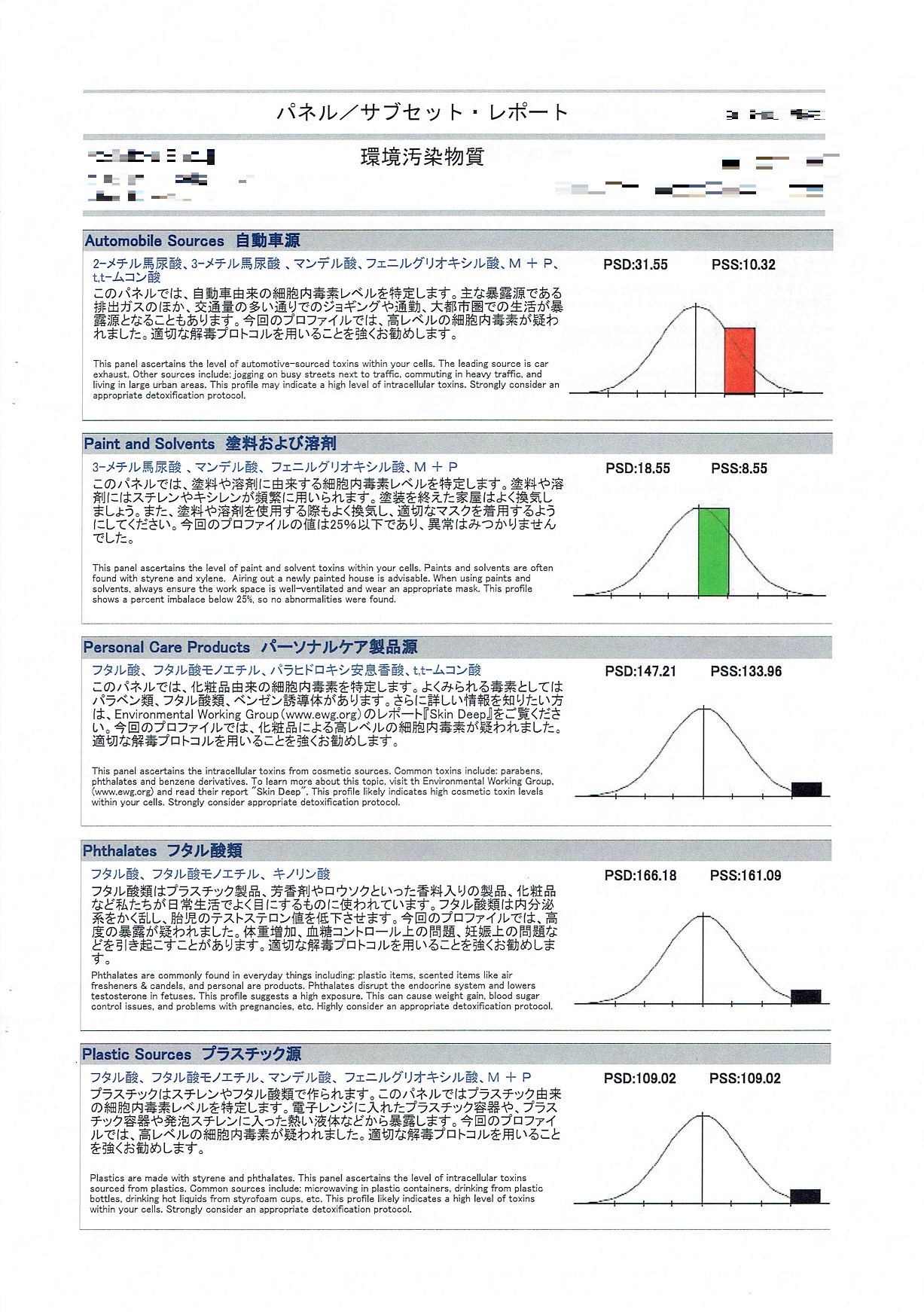
Panel/Subset Report
Environmental pollutants
Car source
2-methylhippuric acid, 3-methylhippuric acid, mandelic acid, phenylglyoxylic acid, M+P, t,t-muconic acid
Paints and solvents
3-methyl hippuric acid, mandelic acid, phenylglyoxylic acid, M+P
Personal care product source
Phthalic acid, monoethyl phthalate, para-hydroxybenzoic acid, t,t-muconic acid
Phthalates
Phthalic acid, monoethyl phthalate, quinolinic acid
Plastic source
Phthalic acid, monoethyl phthalate, mandelic acid, phenylglyoxylic acid, M+P
10nd page
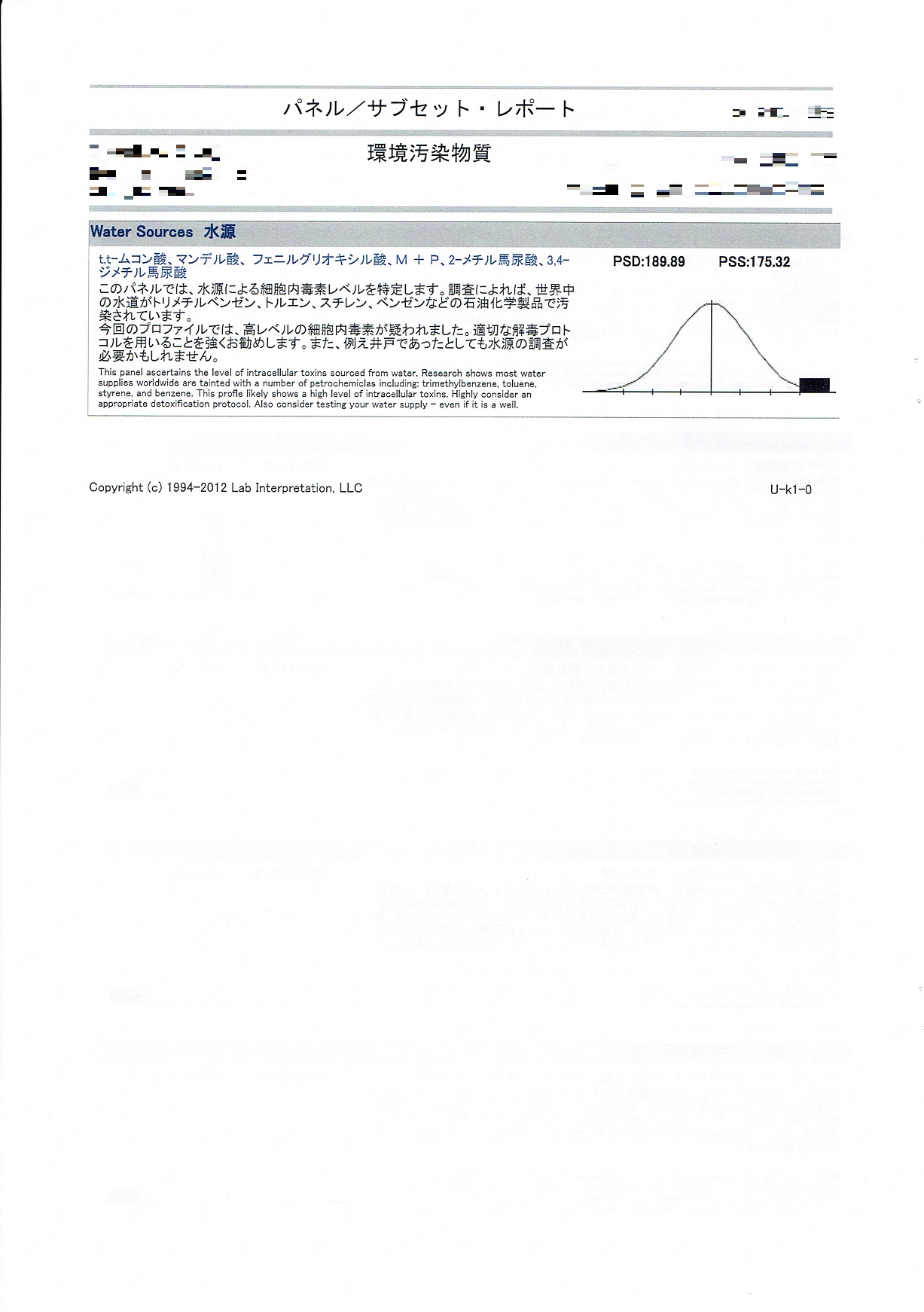
Panel/Subset Report
Environmental pollutants
Water source
t,t-muconic acid, mandelic acid, phenylglyoxylic acid, M+P, 2-methylhippuric acid, 3,4-dimethylhippuric acid
11nd page
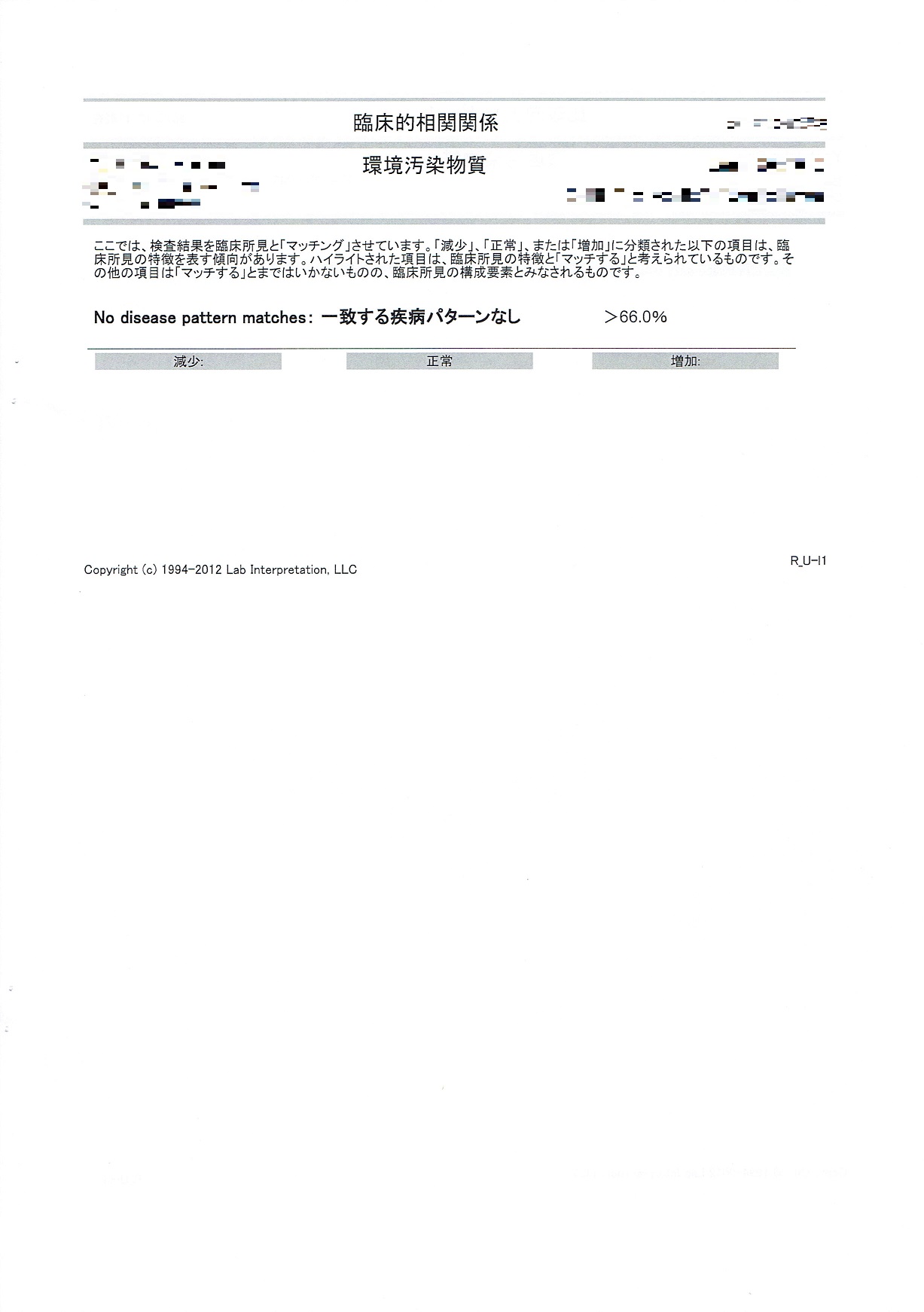
Clinical correlation
Environmental pollutants
Here, the test results are “matched” with the clinical findings. The following items, categorized as “decreased,” “normal,” or “increased,” tend to characterize clinical findings.
Highlighted items are considered to “match” the features of the clinical finding.
The other items are considered to be components of clinical findings, if not “match”.
12nd page
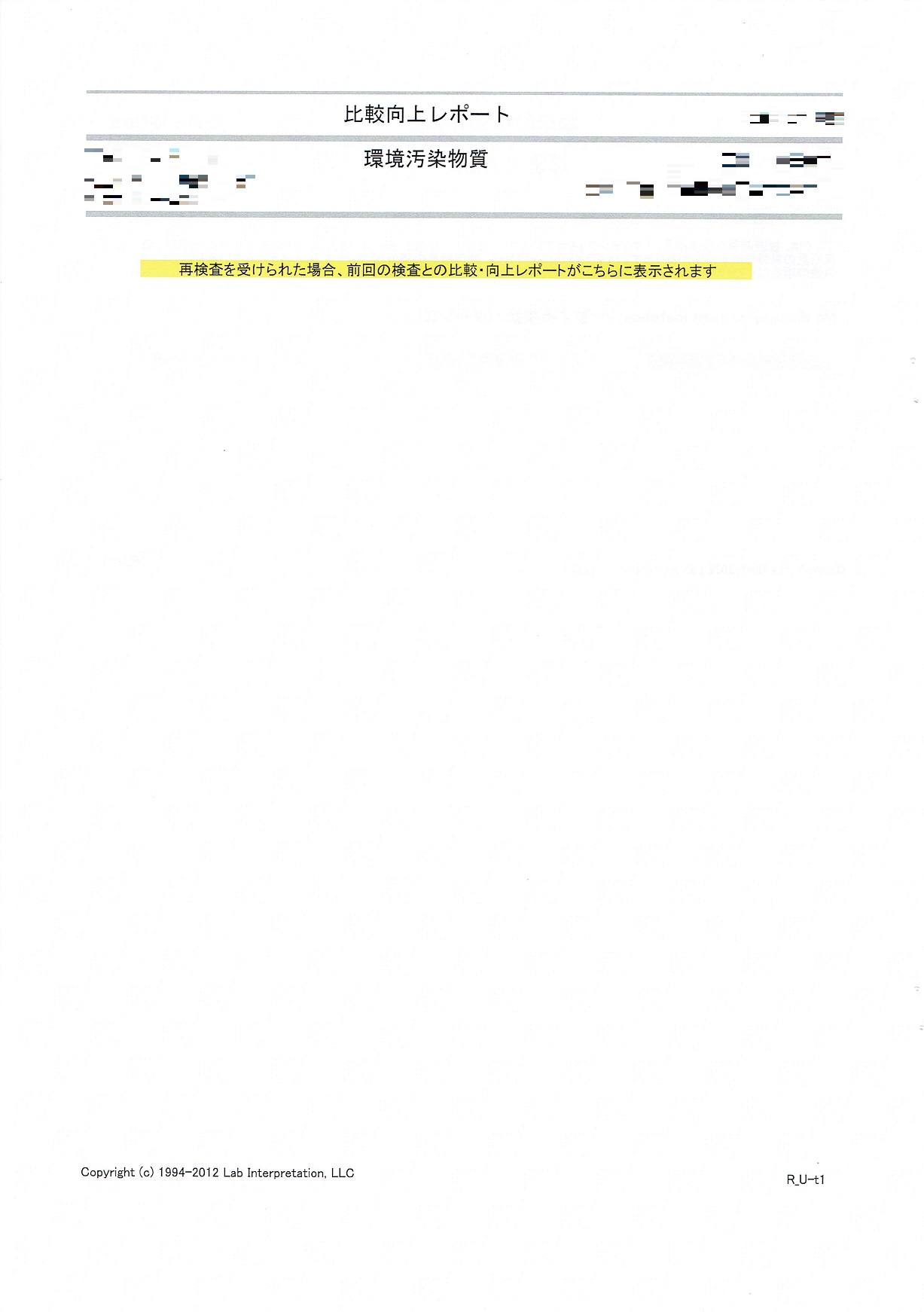
Comparison improvement report
Environmental pollutants
If you have been re-examined, a comparison and improvement report from the previous inspection will be displayed here.